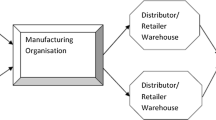Abstract
The multi-criteria supplier segmentation (MSS) has become one of the most important problems and plays a key role in every global company. It is vital for every company to successfully select suppliers, to undertake selection evaluation process for a long time, and to invest enormous of capital and effort to manage supply chain efficiently. This study aims to propose a new fuzzy analytic hierarchy process (FAHP) method for the efficiency evaluation of suppliers with bell-shaped membership functions. Since the MSS is a multi-criteria decision-making problem, we decomposed the problem into two main clusters grouping criteria, including the criterion of capability and the criterion of willingness in the first phase. Then the modified FAHP method is applied to acquire a ranking of the candidate suppliers in the second phase with evaluation of different alternatives. A study from the case company was conducted to choose the best solution alternative(s) for the case company. From the experiments, we show that the proposed method is a very practical and efficient technique for the decision makers to select best options for the MSS in managing supply chain.



Similar content being viewed by others
Explore related subjects
Discover the latest articles, news and stories from top researchers in related subjects.References
Bezdek JC (1978) Fuzzy partitions and relations and axiomatic basis for clustering. Fuzzy Sets Syst 1:111–127
Buckley JJ (1985) Fuzzy hierarchical analysis. Fuzzy Sets Syst 17:233–247
Cheng CH, Yang KL, Hwang CL (1999) Evaluating attack helicopters by AHP based on linguistic variable weight. Eur J Oper Res 116(2):423–443
Day M, Magnan GM, Moeller MM (2010) Evaluating the bases of supplier segmentation: a review and taxonomy. Ind Mark Manag 39(4):625–639
De Cock M, Bodenhofer U, Kerre EE (2000) Modelling linguistic expressions using fuzzy relations. In: Proceedings of 6th international conference on soft computing, pp 353–360
Kahraman C, Ulukan Z, Tolga E (1998) A fuzzy weighted evaluation method using objective and subjective measures. ICSC Symp Eng Intell Syst 1:57–63
Kuzmin VB (1982) Building group decisions in spaces of strict and fuzzy binary relations. Nauka, Moscow (in Russian)
Lee M, Pham H, Zhang X (1999) A methodology for priority setting with application to software development process. Eur J Oper Res 118:375–389
Mikhailov L (2003) Deriving priorities from fuzzy pairwise comparison judgements. Fuzzy Sets Syst 134(3):365–385
Rezaei J, Ortt R (2012a) A multi-variable approach to supplier segmentation. Int J Prod Res 50(16):4593–4611
Rezaei J, Ortt R (2012b) Two multi-criteria approaches to supplier segmentation. In: Advances in production management systems, value networks: innovation, technologies, and management, pp 317–325
Rezaei J, Ortt R (2013a) Multi-criteria supplier segmentation using a fuzzy preference relations based AHP. Eur J Oper Res 225:75–84
Rezaei J, Ortt R (2013b) Supplier segmentation using fuzzy logic. Ind Mark Manag 42(4):507–517
Roylance D (2006) Purchasing performance: measuring, marketing and selling the purchasing. Ashgate Publishing, UK
Saaty TL, Kearns KP (1985) Analytical planning: the organization of systems. Pergamon Press, Oxford
Salii VN (1965) Binary L-relations. Matematika 44(1):133–145
Sausen K, Tomczak T, Herrmann A (2005) Development of a taxonomy of strategic market segmentation: a framework for bridging the implementation gap between normative segmentation and business practice. J Strateg Mark 13:151–173
Turnbull PW (1990) A review of portfolio planning models for industrial marketing and purchasing management. Eur J Mark 24(3):7–22
van Laarhoven PJM, Pedrycz W (1983) A fuzzy extension of Saaty’s priority theory. Fuzzy Sets Syst 11:199–227
Varley R (2006) Retail product management: buying and merchandising, 2nd edn. Taylor & Francis Group, Routledge
Wang TC, Chen YH (2008) Applying fuzzy linguistic preference relations to the improvement of consistency of fuzzy AHP. Inf Sci 178:3755–3765
Zadeh LA (1965) Fuzzy sets. Inf Control 8:338–353
Zadeh LA (1975a) The concept of a linguistic variable and its application to approximate reasoning—I. Inf Sci 8(1):199–249
Zadeh LA (1975b) The concept of a linguistic variable and its application to approximate reasoning—II. Inf Sci 8(2):301–357
Acknowledgments
The authors would like to thank the Ministry of Science and Technology of Taiwan (ROC) for financially supporting this research under Contract No. MOST103-2410-H-011-022.
Author information
Authors and Affiliations
Corresponding author
Additional information
Communicated by V. Loia.
Rights and permissions
About this article
Cite this article
Lo, SC., Sudjatmika, F.V. Solving multi-criteria supplier segmentation based on the modified FAHP for supply chain management: a case study. Soft Comput 20, 4981–4990 (2016). https://doi.org/10.1007/s00500-015-1787-1
Published:
Issue Date:
DOI: https://doi.org/10.1007/s00500-015-1787-1




